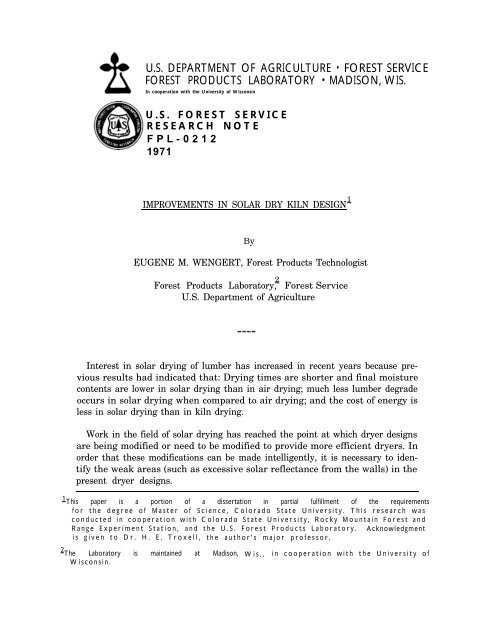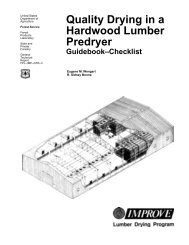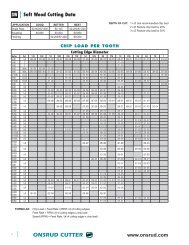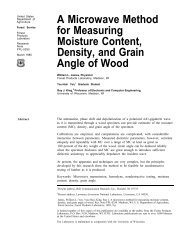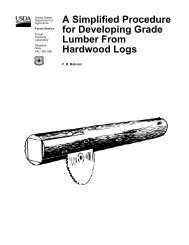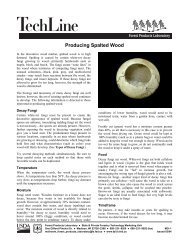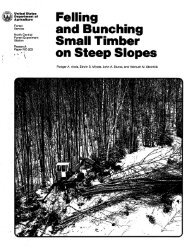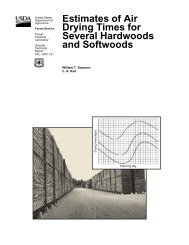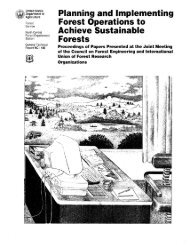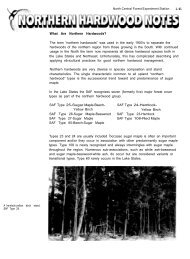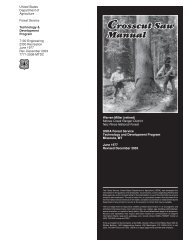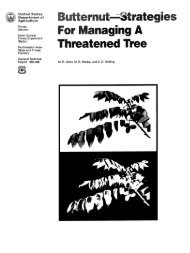Improvements in Solar Dry Kiln Design - Forest Products Laboratory
Improvements in Solar Dry Kiln Design - Forest Products Laboratory
Improvements in Solar Dry Kiln Design - Forest Products Laboratory
Create successful ePaper yourself
Turn your PDF publications into a flip-book with our unique Google optimized e-Paper software.
U.S. DEPARTMENT OF AGRICULTURE • FOREST SERVICEFOREST PRODUCTS LABORATORY • MADISON, WIS.In cooperation with the University of Wiscons<strong>in</strong>U.S. FOREST SERVICERESEARCH NOTEFPL-02121971IMPROVEMENTS IN SOLAR DRY KILN DESIGN 1ByEUGENE M. WENGERT, <strong>Forest</strong> <strong>Products</strong> Technologist<strong>Forest</strong> <strong>Products</strong> <strong>Laboratory</strong>, 2 <strong>Forest</strong> ServiceU.S. Department of AgricultureInterest <strong>in</strong> solar dry<strong>in</strong>g of lumber has <strong>in</strong>creased <strong>in</strong> recent years because previousresults had <strong>in</strong>dicated that: <strong>Dry</strong><strong>in</strong>g times are shorter and f<strong>in</strong>al moisturecontents are lower <strong>in</strong> solar dry<strong>in</strong>g than <strong>in</strong> air dry<strong>in</strong>g; much less lumber degradeoccurs <strong>in</strong> solar dry<strong>in</strong>g when compared to air dry<strong>in</strong>g; and the cost of energy isless <strong>in</strong> solar dry<strong>in</strong>g than <strong>in</strong> kiln dry<strong>in</strong>g.Work <strong>in</strong> the field of solar dry<strong>in</strong>g has reached the po<strong>in</strong>t at which dryer designsare be<strong>in</strong>g modified or need to be modified to provide more efficient dryers. Inorder that these modifications can be made <strong>in</strong>telligently, it is necessary to identifythe weak areas (such as excessive solar reflectance from the walls) <strong>in</strong> thepresent dryer designs.1 This paper is a portion of a dissertation <strong>in</strong> partial fulfillment of the requirementsfor the degree of Master of Science, Colorado State University. This research wasconducted <strong>in</strong> cooperation with Colorado State University, Rocky Mounta<strong>in</strong> <strong>Forest</strong> andRange Experiment Station, and the U.S. <strong>Forest</strong> <strong>Products</strong> <strong>Laboratory</strong>. Acknowledgmentis given to Dr. H. E. Troxell, the author’s major professor.2 The <strong>Laboratory</strong> is ma<strong>in</strong>ta<strong>in</strong>ed at Madison, Wis., <strong>in</strong> cooperation with the University ofWiscons<strong>in</strong>.
FPL-0212 -2-
The objective of this study was to identify the major energy losses <strong>in</strong> the solardryer at Colorado State University, and then to suggest various design changes,based on theoretical considerations, to reduce these losses to leave more energyfor the primary task of dry<strong>in</strong>g wood.Previous <strong>Solar</strong> <strong>Dry</strong><strong>in</strong>g ResearchEarly work on solar dry<strong>in</strong>g of wood was done by C. L. Johnson 3 <strong>in</strong> 1961 at theU.S. <strong>Forest</strong> <strong>Products</strong> <strong>Laboratory</strong>, although the idea of us<strong>in</strong>g solar energy for dry<strong>in</strong>gwood was mentioned several years earlier by M. L. Ghai. 4 S<strong>in</strong>ce Johnson’searly work, studies have been conducted at the U.S. <strong>Forest</strong> <strong>Products</strong> <strong>Laboratory</strong>(Madison, Wis.); Colorado State University and the Rocky Mounta<strong>in</strong> <strong>Forest</strong> andRange Experiment Station (Fort Coll<strong>in</strong>s, Colo.); the Institute of Tropical <strong>Forest</strong>ry(Puerto Rico); the <strong>Forest</strong> <strong>Products</strong> Research Institute (Philipp<strong>in</strong>es); the Divisionof <strong>Forest</strong> <strong>Products</strong>, Commonwealth Scientific and Industrial Research Organization(Australia); the <strong>Forest</strong> Research Institute (India); the Government <strong>Forest</strong>Experiment Station (Japan); South African Timber Research Unit (South Africa);Centre Technique <strong>Forest</strong>ier Tropical (Madagascar); and the Uganda <strong>Forest</strong>Department (Uganda). Results of much of this research are <strong>in</strong>cluded <strong>in</strong> the additionalreferences at the end of this report.Most of the solar kilns used by these organizations <strong>in</strong> their studies have beenconstructed of a wood frame covered with a transparent or translucent materialsuch as glass, plastic, or fiberglass. Often one wall was not transparent but hada solid door to permit easy load<strong>in</strong>g or unload<strong>in</strong>g. In most studies the advantagesof solar dry<strong>in</strong>g over air dry<strong>in</strong>g are reported as (1) less lumber degrade, (2) shorterdry<strong>in</strong>g times, and (3) lower f<strong>in</strong>al moisture contents.The solar dryer at Colorado State University (fig. 1) is a typical solar dryer.It is a frame structure, 18 feet (east to west) by 10 feet (north to south), withtranslucent fiberglass walls and roof. The roof is at an angle of 17°, fac<strong>in</strong>g south,mak<strong>in</strong>g the south wall about 7 feet high and the north wall 10 feet. A slid<strong>in</strong>g plywooddoor is the north wall. The floor is concrete several <strong>in</strong>ches thick. Twoelectric fans <strong>in</strong> the dryer circulate air though the load at about 250 feet perm<strong>in</strong>ute. Four small open<strong>in</strong>gs, two on the east wall and two on the west wall, areused for vent<strong>in</strong>g.3 C. Johnson. 1961. W<strong>in</strong>d-Powered <strong>Solar</strong>-Heated Lumber <strong>Dry</strong>er. So. Lumberman 203(2532):41-42, 44.4 M.L. Ghai. 1955. Season<strong>in</strong>g of Timber with <strong>Solar</strong> Energy. In <strong>Solar</strong> Energy ResearchEds. F. Daniels and J. A. Duffie, Univ. of Wiscons<strong>in</strong> Press, Madison.-3-
<strong>Solar</strong> <strong>Dry</strong>er TheoryA solar dryer with transparent or translucent walls is designed to transmitthe largest practical percentage of the <strong>in</strong>cident solar energy <strong>in</strong>to the dryer. Surfaces<strong>in</strong>side the dryer are pa<strong>in</strong>ted dull or flat black so that as much of the transmittedenergy as possible is then absorbed. When this energy is absorbed, theabsorb<strong>in</strong>g surfaces are heated. Energy is then transferred from the heated surfacesto the air <strong>in</strong> the dryer, primarily by convection. The air, circulated by fans,then transfers energy to the lumber where it evaporates and moves water fromthe wood.However, this process of convert<strong>in</strong>g solar energy <strong>in</strong>to energy for evaporat<strong>in</strong>gand mov<strong>in</strong>g water is not very efficient. As an example, about 1 million B.t.u.’sare required to dry 1,200 board feet of lumber from 50 percent to 12 percentmoisture content. At Fort Coll<strong>in</strong>s, Colo., a horizontal solar energy collector orsolar dryer roof with an efficiency of 100 percent and an area of 20.0 square feetcould collect 1 million B.t.u.’s <strong>in</strong> two typical summer days or five typical w<strong>in</strong>terdays.’ On the other hand, it is estimated that the solar dryer at Fort Coll<strong>in</strong>s, witha roof area of about 200 square feet, would take almost a week <strong>in</strong> summer andover 2 weeks <strong>in</strong> w<strong>in</strong>ter to dry 1,200 board feet from 50 to 12 percent. The majorquestion is, “Where is the <strong>in</strong>com<strong>in</strong>g solar energy go<strong>in</strong>g if it isn’t be<strong>in</strong>g used todry the lumber?’Experimental Approach--TheoryTo def<strong>in</strong>e the system to be studied, an imag<strong>in</strong>ary boundary was considered ascompletely around the kiln. Any energy pass<strong>in</strong>g <strong>in</strong>to the volume enclosed by theboundary was an energy ga<strong>in</strong>; any energy pass<strong>in</strong>g out, an energy loss. As aresult of this def<strong>in</strong>ition, the follow<strong>in</strong>g energy changes were considered:Ga<strong>in</strong>s.--(1) <strong>in</strong>cident solar energy, (2) <strong>in</strong>cident longwave or <strong>in</strong>frared energy,and (3) “dry<strong>in</strong>g power” or <strong>in</strong>ternal energy of the air enter<strong>in</strong>g through the vents.5 It should be noted that the calculations, when considered <strong>in</strong> terms of a solar dryer,should also <strong>in</strong>clude such other sources of energy <strong>in</strong>put as energy from the fans andsolar energy <strong>in</strong>put through the walls. This would mean that an ideal dryer could drylumber <strong>in</strong> even less time than the times <strong>in</strong>dicated.FPL-0212 -4-
Losses.--(l) outgo<strong>in</strong>g solar energy, (2) outgo<strong>in</strong>g longwave energy, (3) <strong>in</strong>ternalenergy of the air exit<strong>in</strong>g from the vents, and (4) sensible heat loss.Storage or chances.--(1) changes <strong>in</strong> temperature of material (water, wood,air, etc.) <strong>in</strong> the enclosed volume, and (2) changes of state of water (e.g., liquidto vapor).By us<strong>in</strong>g the imag<strong>in</strong>ary boundary or energy balance approach, the energy ga<strong>in</strong>smust equal the energy losses plus the <strong>in</strong>crease <strong>in</strong> energy of the material <strong>in</strong> theenclosed volume. If the measurements do not confirm this equality, then eithera significant energy term has been omitted or an energy term has not beenmeasured accurately.To simplify this experiment, the imag<strong>in</strong>ary boundary around the solar kiln wasmoved slightly so that the north wall (a slid<strong>in</strong>g door) and the floor conta<strong>in</strong>ed theboundary, while the boundary rema<strong>in</strong>ed outside the other three walls and roof.This reposition<strong>in</strong>g meant that the only term that had to be measured for the northwall and the floor was energy conduction because these surfaces were opaque.Experimental Approach--InstrumentationOne simplification was necessary due to the <strong>in</strong>strumentation used--the longwaveenergy terms (<strong>in</strong>com<strong>in</strong>g and outgo<strong>in</strong>g) were not measured separately; rathera net radiation term was measured (<strong>in</strong>com<strong>in</strong>g m<strong>in</strong>us outgo<strong>in</strong>g). <strong>Solar</strong> irradiationvalues were measured with silicon solar cells located <strong>in</strong> various positionsaround the dryer. Sensible heat or convection losses from the walls were determ<strong>in</strong>edby measur<strong>in</strong>g the temperature difference between the air and the wall, andmultiply<strong>in</strong>g this difference by an empirically determ<strong>in</strong>ed convection coefficient.Conduction <strong>in</strong> the north wall and floor was determ<strong>in</strong>ed by multiply<strong>in</strong>g the temperaturegradient by a conduction coefficient for that material. Energy storage wasdeterm<strong>in</strong>ed by multiply<strong>in</strong>g the change <strong>in</strong> temperature of a material over a periodof time by the material’s density and specific heat. The energy utilized <strong>in</strong>chang<strong>in</strong>g water from a liquid to a gas was determ<strong>in</strong>ed by measur<strong>in</strong>g the weightof water lost from the lumber <strong>in</strong> the dryer and multiply<strong>in</strong>g this weight loss bythe latent heat of evaporation.-5-
Results and DiscussionData were taken dur<strong>in</strong>g, the morn<strong>in</strong>g hours of clear days dur<strong>in</strong>g the summerof 1967. The data are summarized <strong>in</strong> table 1 <strong>in</strong> terms of the amount of energyga<strong>in</strong>ed or lost as a percentage of the <strong>in</strong>com<strong>in</strong>g solar radiation. Five energylosses account for about 84 percent of the <strong>in</strong>com<strong>in</strong>g solar energy: losses by convection(sensible heat loss), 29 percent; outgo<strong>in</strong>g solar energy, 17 percent:ventilation, 14 percent; net longwave radiation, 13 percent; and conduction throughthe floor, 11 percent. The rema<strong>in</strong><strong>in</strong>g 16 percent of solar energy was utilized fordry<strong>in</strong>g the wood and for m<strong>in</strong>or losses.Table 1.--Summary of energy distribution <strong>in</strong> the solar dryer1 Total of column exceeds 100 percent due to experimentalerror and due to other energy <strong>in</strong>put (e.g., from the fans)which was not considered.Although these results are subject to a 2 to 5 percent experimental error dueto the <strong>in</strong>strumentation used, they do <strong>in</strong>dicate that five energy-loss terms arerelatively large and must be reduced to utilize more of the <strong>in</strong>com<strong>in</strong>g solar energyfor dry<strong>in</strong>g woodReduc<strong>in</strong>g the LossesThe follow<strong>in</strong>g section discusses each of the five losses and <strong>in</strong>dicates methodsof reduc<strong>in</strong>g them These methods apply, <strong>in</strong> general, to any solar dryer designwith translucent or transparent walls.FPL-0212 -6-
ConvectionThe easiest method of reduc<strong>in</strong>g the convective loss would be to reduce the temperaturedifference between the walls and the outside air. This could be accomplishedby us<strong>in</strong>g two layers of translucent material with a dead air space betweenthem for the walls. If this modification is made to the exist<strong>in</strong>g solar dryer, thesecond layer should be as transparent as possible to solar radiation so thatsolar reflection losses do not <strong>in</strong>crease. In addition, by us<strong>in</strong>g two layers of wallmaterial, the amount of longwave radiation lost through the walls will decreasebecause of the lower temperature of the exterior wall.Reflection and Transmissionof <strong>Solar</strong> EnergyThe wall material must be transparent or translucent to permit the solarenergy to enter the dryer, but the more transparent the material, the larger theamount of energy transmitted out aga<strong>in</strong> through the walls. The translucent wallmaterial works very well because it permits a high percentage of solar radiationto enter the dryer and does reduce the transmission loss.As an improvement to the present dryer design, several baffles, verticallyoriented and runn<strong>in</strong>g north to south, could be placed <strong>in</strong> the dryer. These bafflesshould be pa<strong>in</strong>ted black to absorb the maximum amount of solar radiation. Thiswould reduce the amount of solar energy that enters the dryer, but then passesdirectly out aga<strong>in</strong>.Ventilation LossesVentilation (the exchange of air <strong>in</strong> the dryer with the outside air) is necessaryto keep the humidity <strong>in</strong>side the dryer at a moderate level so dry<strong>in</strong>g can take place.However, the ventilation <strong>in</strong> the present dryer can be improved. The present designresults <strong>in</strong> fresh air be<strong>in</strong>g brought <strong>in</strong>to the dryer at a rate of 600 cubic feet perm<strong>in</strong>ute. The air, once <strong>in</strong> the dryer, moves <strong>in</strong>to the upper section where, with airpreviously <strong>in</strong> the dryer, it is heated. Some of this heated air is then exhausted tothe outside. The rema<strong>in</strong><strong>in</strong>g air is passed through the lumber. The major drawbackto this design is that some of the heated air is exhausted before it does any workor supplies any heat to the lumber.-7-
A better ventilation design would be to exhaust some of the air <strong>in</strong> the kiln immediatelyafter it passed through the lumber pile. This can be accomplished bypower vent<strong>in</strong>g with a small fan <strong>in</strong>stalled on the “low-pressure” side of the kiln.The fresh air <strong>in</strong>take vent would also be on the low-pressure side. In addition toobta<strong>in</strong><strong>in</strong>g more work and heat from the air, this method would also reduce thetemperature difference between the enter<strong>in</strong>g and leav<strong>in</strong>g air through the ventsand further reduce the energy lost by ventilation.Losses by Longwave RadiationThe losses by longwave radiation are difficult to reduce. Their magnitude isaffected by the temperature <strong>in</strong>side the dryer and by the ability of the walls totransmit longwave radiation. Decreas<strong>in</strong>g the temperature <strong>in</strong>side the dryer woulddefeat the major purpose of the dryer. However, decreas<strong>in</strong>g the transmission oflongwave radiation through the walls would decrease the longwave loss. This reflectioncould be accomplished, <strong>in</strong> part, by us<strong>in</strong>g two layers of wall material.Also, it could be accomplished by coat<strong>in</strong>g the wall surfaces with <strong>in</strong>frared reflect<strong>in</strong>gchemicals (such as titanium dioxide).Losses Through the FloorConcrete is a relatively poor thermal <strong>in</strong>sulator and therefore is not a suitablematerial to be used for a floor <strong>in</strong> a solar dryer. A wood floor would be muchbetter. An excellent floor design would be a composite floor with wood as anunderlayment and concrete or asphalt as a cover<strong>in</strong>g material.ConclusionsThis study has shown five major areas where energy losses exist <strong>in</strong> the presentsolar dryer design. These losses account for nearly all of the energy lost <strong>in</strong> thisdryer:1. Convection losses from the walls and roof;2. Reflection and transmission of solar energy;3. Ventilation losses through the vents;4. Longwave radiation losses;5. Conduction losses through the floor.Corrective design procedures are available which will reduce each of theselosses.FPL-0212 -8-
Additional References on <strong>Solar</strong> <strong>Dry</strong><strong>in</strong>gBanks, C. H.1969. <strong>Solar</strong> dry<strong>in</strong>g of timber--a development study. Hout No. 10. SouthAfrican CSIR Timber Research Unit. 27 pp.Cas<strong>in</strong>, R. F.1967. <strong>Solar</strong> dryer for lumber. FPRI Tech. Note No. 76, 3 pp. <strong>Forest</strong> Prod.Res. Inst., Philipp<strong>in</strong>es.Chudnoff, M., Maldonado, E. D., and Goytia, E.1966. <strong>Solar</strong> dry<strong>in</strong>g of tropical hardwoods. U.S. <strong>Forest</strong> Serv. Res. Paper ITF-2,26 pp. Inst. Trop. <strong>Forest</strong>., Puerto Rico.Gueneau, P.1970. An experiment <strong>in</strong> solar dry<strong>in</strong>g wood. For. Trop. No. 131, pp. 69-78.Maldonado, E. D.1962. <strong>Solar</strong> radiation used to dry mahogany lumber <strong>in</strong> Puerto Rico. ITF NoteNo. 14. Inst. Trop. <strong>Forest</strong>., Puerto Rico., and Peck, E. C.1962. <strong>Dry</strong><strong>in</strong>g by solar radiation <strong>in</strong> Puerto Rico. <strong>Forest</strong> Prod. J. 12(10): 487-488.Peck, E. C.1962. <strong>Dry</strong><strong>in</strong>g 4/4 red oak by solar heat. <strong>Forest</strong> Prod. J. 12(3): 103-107.1962. <strong>Dry</strong><strong>in</strong>g lumber by solar energy. Sun at Work, 3rd Quarter: 4-6.Plumptre, R. A.1967. The design and operation of a small solar season<strong>in</strong>g kiln on the Equator<strong>in</strong> Uganda. Commonwealth <strong>Forest</strong>. Rev. (London) 46(4), No. 130:298-309.Rehman, M. A., and Chawla, O. P.1961. Season<strong>in</strong>g of timber us<strong>in</strong>g solar energy. Indian <strong>Forest</strong>. Bull. No. 229.<strong>Forest</strong> Res. Inst., Dehra Dun, India.-9-
Troxell, H. E.1963. <strong>Solar</strong> lumber dry<strong>in</strong>g <strong>in</strong> Colorado. & Proceed<strong>in</strong>gs, Fifteenth AnnualMtg., Western <strong>Dry</strong> <strong>Kiln</strong> Clubs, Portland., and Mueller, L. A.1968. <strong>Solar</strong> lumber dry<strong>in</strong>g <strong>in</strong> the Central Rocky Mounta<strong>in</strong> Region. <strong>Forest</strong>Prod. J. 18(l): 19-24.Uganda <strong>Forest</strong> Department1964-66. <strong>Solar</strong> season<strong>in</strong>g. Wood News (Kampala, Uganda) 4: 3-5; 5: 7; 7: 6-7;8: 9.FPL-0212 -10- 1.5-10-8-71


